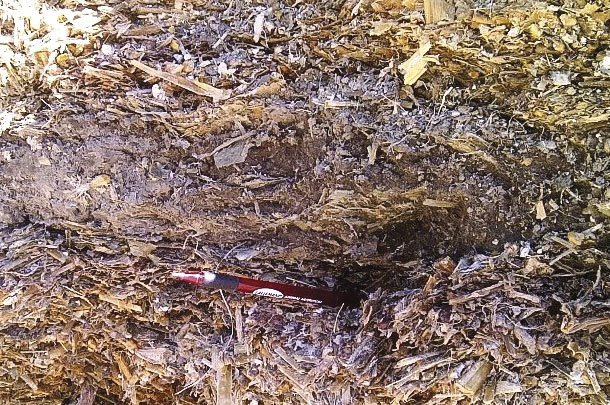When a crop is harvested to be ensiled, it’s a race against time to minimize losses and preserve a majority of dry matter and nutrients in the form of digestible fiber, protein and energy. In order to have a successful preservation, there needs to be an absence of oxygen in the forage mass, along with sufficient production of organic (lactic) acids by lactic acid bacteria population.
There are a variety of factors that impact the ensiling process, and one of those is soil contamination. The amount of soil brought into the silo with the forage can be extrapolated through the total amount of ash.
Ash in the silage
The plants’ internal ash provides minerals like magnesium, calcium and potassium that can be utilized by ruminants, although it adds no calories. The average ash content in forages is normally 3 to 5 percent in corn, 6 to 8 percent in grasses and 8 to 10 percent in legumes.
On the other hand, high ash content due to soil contamination is characterized by elevated concentrations of iron, aluminum and silica. According to the University of Wisconsin Soil and Forage Analysis Laboratory, haylage samples contain approximately 4 percent ash contamination.
There are different manners that soil contaminates the plant: weather (rain, flooding, wind), plant lodging, mechanical operations during harvest and soil from dirt pads (in and around the storage area).
Lowering the cutting height increases the total yield but will likely increase the content of ash. In addition, it reduces the forage quality due to the high proportion of fiber and will negatively affect the stand life of some grasses (e.g., orchardgrass, timothy). Setting the height between 2.5 and 3 inches seems to be the best alternative.
Heavy rain splashing soil onto leaves – and extreme weather conditions like hurricanes and flooding of crop fields – can result in contamination (Picture 1).

On the flip side, dry weather and drought conditions may also contribute to soil contamination in terms of dusty winds and dust from dirt roads near the field.
Swath width may have an impact on ash contamination, and one would expect the issue when wide swathing – due to sometimes driving over the mowed swath.
However, research has not shown significant differences in ash levels, likely because the bottom portion of a narrow swath remains wet for a longer period of time, sagging to the ground and leading to soil contamination when the windrow is picked up. So keep your forage on top of the stubble, not in contact with the ground.
The type of knives on disc mowers can also impact soil contamination: Curved knives can retrieve forage from the ground better, but they also tend to pick up more ash; flat horizontal knives create less suction and introduce less soil in the mowed forage.
Mergers are a better option than rakes because the windrow is picked up and moved horizontally by a conveyer rather than being rolled across the ground, resulting in 1 to 2 percent less ash on forage. If rakes or tedders are the only option, make sure the tines are adjusted so they won’t touch the ground and move soil into the forage. Scalping the field is more likely in uneven fields or if driving fast, which causes the equipment to jump up and down.
Storage structures can also be a source of soil contamination. Under dry weather conditions, bag silos and wrapped bales add minimal external ash to the silage. However, under wet conditions, mud can be easily mixed into the silage during feedout.
Pile and bunker silos set directly on the ground will incorporate soil into the crop during filling (Picture 2) or feedout.

The magnitude of contamination will depend on the silo design, drainage conditions and the operator skill level. Under wet, muddy conditions, soil can accumulate onto tires and tire treads of tractors and trucks, bringing more dirt into the forage mass.
Feeding implications
Ash can be a contaminant of the fiber content. Although pectin is in the plants’ cell walls, the “fiber” portion for ruminant diets relates to the amount and proportion of cellulose, hemicellulose and lignin. Moreover, only the organic matter in fiber will generate energy to the animal. Dirt is not a nutrient. Excess ash from soil contamination replaces real, productive nutrients in the diet.
Soil contamination can become a big issue when formulating a diet, especially for high-producing cows or if low-fiber formulations are fed. As much as 4 pounds of dirt could be fed per cow daily. According to Dan Undersander, for every 2 points of external ash contamination, there can be a 5-point decrease in relative forage quality and a potential decline of as much as 170 pounds of milk per ton of alfalfa.
Although soil contamination affects the ensiling process, some plants – corn, specifically – can be quite forgiving, according to Limin Kung Jr. while presenting the results of ensiled whole corn plants hit by Hurricane Irene in 2011.
Soil-contaminated silage had higher contents of ash, iron and aluminum and lower in vitro digestibility of neutral detergent fiber and concentration of net energy of lactation compared to “clean silage.” Since corn has low buffering capacity, the ability to resist pH drop and more-than-sufficient levels of soluble sugars, the high level of soil contamination had a minor impact on the ensiling process.
Furthermore, feeding the compromised silage resulted in issues for half of the herds involved in the study (lower intake and milk production, high somatic cell counts, lowered milkfat and repeated breeding).
Soil contamination probably will not come alone. Issues with unwanted spoilage micro-organisms, poor fermentation and impaired quality of silage are likely to be present and compound challenges to the animals. ![]()
PHOTO 1: Corn plants after flooding in Australia.
PHOTO 2: Face of a corn silage bunker with soil contamination. Photos courtesy of Lallemand.
Bob Charley is employed by Lallemand Animal Nutrition, North America as a forage products manager.
References omitted but are available upon request. Click here to email an editor.

-
Renato J. Schmidt
- Forage Products Specialist
- Lallemand Animal Nutrition – North America
- Email Renato J. Schmidt






